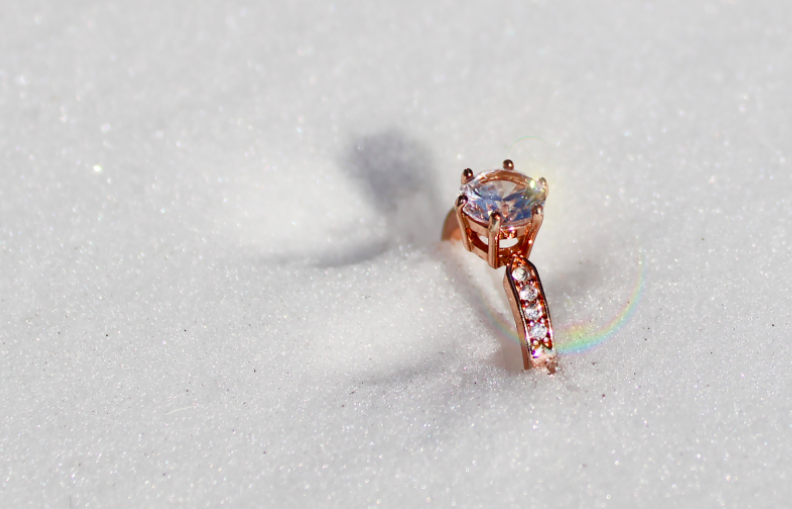Sustainable Diamonds: Are Lab-Grown Diamonds Eco-Friendly and Ethical?
When you think of being environmentally conscious, you probably think of reducing the use of disposable plastics and carrying around reusable straws and coffee cups. And when you are looking for the perfect piece of jewelry for yourself, you may not think much of choosing a sustainable diamond.
However, it is well worth it to choose sustainable jewelry. Sustainable diamonds are eco-friendly, more ethical, and can save your money.
What Are Sustainable Diamonds?
Sustainable Diamonds are diamonds that have been ethically sourced. This means that they are not extracted from the earth by miners. This helps to prevent the depletion of natural resources.
What is the Meaning of Sustainable?
Sustainable products do not compromise the earth's resources for the sake of future generations. In other words, their production does not threaten the environment but saves it. In this sense, Lab-Grown Diamonds are sustainable products because they do not require the extraction of diamonds from the earth.
Are Sustainable Diamonds Ethical?
Sustainable Diamonds are the ethical choice for the environment. They do not need to be mined from the earth. This helps to maintain the balance of the ecosystem.
Are Sustainable Diamonds Eco-Friendly?
Yes, Sustainable Diamonds are environmentally friendly. Many people are concerned about the environmental damage caused by mining, such as soil erosion, deforestation, and water pollution. However, if you still want to get your hands on diamond jewelry, a Lab-Grown Diamond is the place to go.
Are Sustainable Diamonds Affordable?
Sustainable Diamonds have no overhead costs such as mining and transportation. As a result, they are not only sustainable but also offer excellent cost performance. They can offer you up to 50% larger diamonds depending on your budget.
Why Mined Diamonds Are Not Sustainable?
While diamond mining is less harmful to the environment than other types of mining, it can still cause significant damage. Due to improper planning and regulation, diamond mining has wreaked havoc in Canada, Africa, and elsewhere.
Let's take a look at why Mined Diamonds are not sustainable.
Mined Diamonds Have a Negative Environmental Impact
Traditional diamond mining depletes the earth's delicate landscape, causes irreversible ecological destruction, and burns hundreds of millions of gallons of diesel fuel per year in a single mine. The most common method of diamond mining is called "Pit mining," which involves digging a hole in the ground and extracting the stone directly from it. Pit mining requires enormous amounts of energy, including heavy machinery, hydraulic excavators, and trucks. Even the most eco-friendly diamond mines are environmentally damaging because diamonds aren’t a renewable resource. For example, the Ekati mine in Canada is known as the most environmentally friendly mine. However, this mine emits the same amount of carbon dioxide per year as driving a car over 600 million kilometers to Mine Diamonds.
Mined Diamonds are Not Conflict Free
The term "Blood" or "Conflict" Diamond was coined in the late 1990s to refer to the violent rebel groups that had taken over the mining areas of mid-western Africa. After violent rebel groups took over the mining areas of mid-west Africa, they illegally exchanged diamonds for weapons and money, fueling further violence and fear. Unbeknownst to consumers, these "Blood" or "Conflict" diamonds were being sold in jewelry stores around the world.
The diamond industry established the Kimberley Process, an international diamond certification system, to prevent "Blood Diamonds" from entering the Western diamond market. However, the Kimberley Process does not protect against violations of workers' rights or unsafe mining conditions, and many so-called Conflict-Free Diamonds are ethically problematic. In addition, it is difficult to trace the origin of Mined Diamonds, so the Kimberley process may serve only a limited purpose. Hiding the origin of a Blood Diamond and pretending that it is a certified diamond is as easy as bribing the right officials.
Mined Diamonds are Not Traceable to Their Origins
As much as ethical consumers would like to believe it, no matter what conscientious diamond traders say, diamonds are not traceable to their origins like fair trade coffee beans or organic produce. Diamonds go through many hands, from mining to sale, and not all of them are honest. Unless the diamond you are buying was mined in a Canadian mine or manufactured in a lab, there is no guarantee that it has been ethically sourced.
Believe it or not, even in the 21st century, with all its technological advances, it is still impossible to trace the original source of a natural diamond unless it comes from a mine in Canada that is affiliated with the CDCC.
Most rough diamonds are sorted and mixed before they are cut and polished. Since most diamonds do not have a certificate of origin, it is impossible to know if the origin is from an artisanal source or a large mining company. Some Canadian diamonds are brand-name and come with a certificate of guarantee. Most diamonds, however, lose their identity as they move through the diamond pipeline.
Beautiful Sustainable Diamond Alternatives to Mined Diamonds
Above is an explanation of why Mined Diamonds are not sustainable. So, do we have to give up our diamond rings, necklaces, etc., just because they are not sustainable?
No, we don't have to give up on them. Thankfully, there are many alternatives to Mined Diamonds.
Real Diamonds
There are some Real Diamonds that are sustainable, unlike Mined Diamonds. What kind of diamonds are they?
Recycle Diamonds
Recycled diamonds that have been Reused, Re-cut and, Re-set are among the most popular Sustainable Diamonds. Although the origin of the diamond is unknown, and it may have been mined in an unsustainable manner, recycling diamonds helps prevent future damage caused by unethical and improper diamond mining. The advantage of recycled diamonds is that you get a diamond that has been mined, but because it has been reused, it is better for the planet.
Lab-Grown Diamonds
Lab-Grown Diamonds are the best alternative to Natural Diamonds, and they are absolutely gorgeous. They are practically the same as Natural Mined Diamonds. The only difference is that they are not mined from the ground but made in a lab. The color of Lab-Grown Diamonds is exactly the same as mined ones, and they follow the same color grading scale as Natural Diamonds.
Are Lab-Grown Diamonds Sustainable?
Land Usage for Lab Grown Diamonds is Much More Sustainable. Every carat of diamond mined requires approximately 100 square feet of land, compared to the. 07 square feet of land used for their lab-grown counterparts. Mined stones also result in almost 6,000 pounds of mineral waste created.
Both Mined Diamonds and Lab-Grown Diamonds are made from pure carbon, have exactly the same brilliance, and have the highest hardness of any stone. The carbon used to create Lab-Grown Diamonds can also be extracted from hair, that’s what the California-based company Sunny Eden™ does.
Overall, Lab-Grown Diamonds offers the exact same product that customers are looking for, but at a more affordable price. This makes them the best alternative to Mined Diamonds.
Are Lab-Grown Diamonds More Sustainable Than Mined Diamonds?
Lab-Grown Diamonds are real gems simply because the carbon crystallization process takes place in a laboratory rather than in the earth's crust. Moreover, it is a great alternative to Mined Diamonds because it reduces the problems associated with mining. But are Lab-Grown Diamonds more sustainable than Mined Diamonds?
Perspective of Water Usage
Water usage is one of the major differences between Lab-Grown Diamonds and Mined Diamonds. A mined diamond uses 126 gallons of water per carat. On the other hand, Lab-Grown Diamonds or Artificial Diamonds consume 18 gallons of water only. Furthermore, Mined Diamonds cause water pollution by continually dumping wastewater into the water supply.
Perspective of Energy Usage
Lab-Grown Diamonds require less energy compared to Mined Diamonds. In general, Lab-Grown Diamonds use 250 million joules per carat, while Mined Diamonds use 538.5 million joules. More interestingly, most of the energy used in the production of Lab-Grown Diamonds is renewable energy.
Perspective of Carbon Emission
The amount of carbon emitted by Lab-Grown Diamonds is significantly lower than that of Mined Diamonds. Lab-Grown Diamonds have a carbon footprint of about 18-22% of mined diamonds. Even more fascinating, some Synthetic Diamond manufacturers are carbon-neutral, while Mined Diamonds produce about 30 pounds of sulfur oxide.
There has been a debate about how eco-friendly Lab-Grown Diamonds are compared to Mined Diamonds. Lab-Grown Diamonds are not 100% environmentally friendly, but recent studies have shown that they are more environmentally friendly than Mined Diamonds.
Perspective of Land Destruction and Waste
When consumers buy diamond rings, they rarely consider that the mining process is destroying the environment, just as they overlook the importance of the diamond's culet. It is very important to know that Mined Diamonds using conventional methods destroy the environment.
In fact, mining one carat of diamond disturbs about 100 square feet of land. And it generates about 5,798 pounds of mineral waste. Mining also impacts biodiversity, making once fertile land unusable after the mining project is finished.
In comparison, Lab-Grown Diamonds destroy only 0.07% of the land and produce one pound of waste per carat. Lab-Grown Diamonds are made under controlled conditions in a building, so there is no threat to the environment or biodiversity.
Pros and Cons of Lab-Grown Diamonds
Lab-Grown Diamonds have the advantage of being more sustainable than Mined Diamonds, but they also have their disadvantages. Here are some of the pros and cons of Lab-Grown Diamonds.
Pros of Lab-Grown Diamonds
The obvious advantage of buying a Lab-Grown Diamond is that you can make a conscious effort to combat climate change. If everyone buys a Lab-Grown Diamond instead of a Mined Diamond, we will be able to halt and actually recover from the massive damage that is being done to our planet on an ongoing basis.
Also, another advantage of opting for a Lab-Grown Diamond or Synthetic Diamond is that they are cheaper than conventionally Mined Diamonds. Lab-Grown Diamonds are not mined, but they have the same physical, chemical, and optical properties as Mined Diamonds.
Cons of Lab-Grown Diamonds
One of the biggest disadvantages of getting a Lab-Grown Diamond is that it is not considered to be as valuable as a Natural Diamond. Since lab-grown diamonds can be manufactured at will, their resale value is negligible.
Lab-Grown Diamonds may bring up their own issues. The manufacturing process for Lab-Grown Diamonds replicates the high temperature and high-pressure environment in which diamonds are formed, which may leave a carbon footprint equal to or greater than that of Mining Diamonds.
Values are important because what we buy as consumers affects the planet and its future. Whether it's an electric car, locally grown vegetables, or sustainable jewelry, we can make choices that reflect our values.
Actively purchase sustainable diamonds that do not have the same negative impact on society and the environment as diamonds mined using conventional methods. This way, when you pass on your precious heirloom to the next generation, you will inherit a planet that is ethical, clean, ecological, and diverse.



























